| Pages:
1
2 |
woelen
Super Administrator
        
Posts: 7976
Registered: 20-8-2005
Location: Netherlands
Member Is Offline
Mood: interested
|
|
Long term experiment: does this make chlorosulfonic acid?
If you mix sulfuric acid and sulfuryl chloride, do you expect formation of chlorosulfonic acid? Chlorosulfonic acid is the intermediate between the
other two:
O2S(OH)2 + O2SCl2 ---> 2 O2S(OH)Cl
Once you have chlorosulfonic acid, it does not separate in sulfuric acid and sulfuryl chloride.
Sulfuryl chloride is known for its sluggish reactions (e.g. when it is added to water, it takes hours or even days before it has hydrolysed and fully
reacted to O2S(OH)2 and HCl).
I tried adding this to concentrated sulfuric acid. When this is done, then it forms a layer on the sulfuric acid. It does not mix, a two-layer system
is formed.
I decided to do the experiment and allow it to run for a long time (weeks, months, years?). For this purpose I made an ampoule in which I put
concentrated sulfuric acid and sulfuryl chloride in an appr. 1 : 1 stoichiometric ratio. Normal sulfuric acid contains a few percent of water and this
may lead to explosion of the ampoule in due time, due to pressure buildup (sulfyryl chloride slowly reacts with water, giving gaseous HCl as one of
the reaction products). So, to avoid this catastrophic end of the experiment, I added a few drops of 20% oleum to the sulfuric acid, such that
certainly all water is used up. There will be a slight excess of SO3. The acid will be 100+ %. This ampoule I sealed and I will put it away and see
what happens over time.
Some pictures of the ampoule:
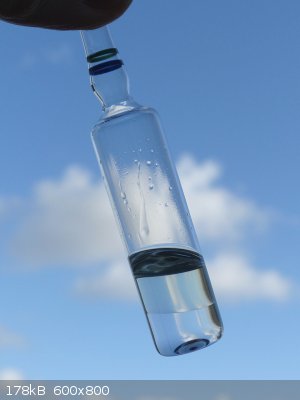
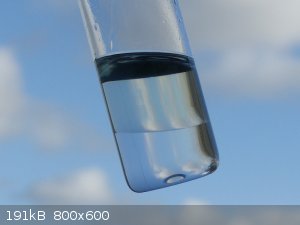
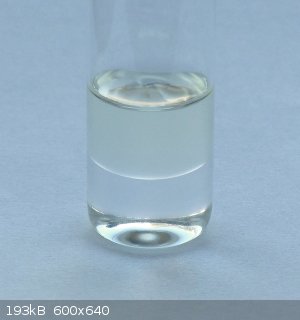
When the ampoule is shaken, then you get some turbid liquid, which quickly settles into two layers again:
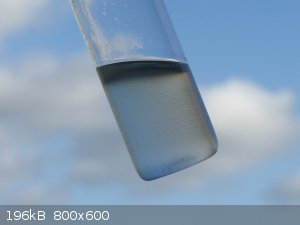
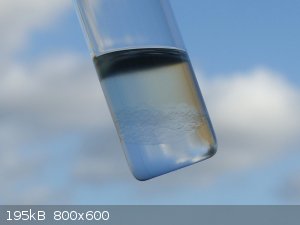
I'll let you know after some time what happened with the ampoule. This kind of long-term experiment is something I like. I have a few other long-term
experiments, but this is the first one I document in this way.
|
|
|
aga
Forum Drunkard
    
Posts: 7030
Registered: 25-3-2014
Member Is Offline
|
|
Wow !
A Time Capsule 
|
|
|
unionised
International Hazard
    
Posts: 5102
Registered: 1-11-2003
Location: UK
Member Is Offline
Mood: No Mood
|
|
Label it carefully.
|
|
|
clearly_not_atara
International Hazard
    
Posts: 2692
Registered: 3-11-2013
Member Is Offline
Mood: Big
|
|
I feel like you should have some kind of phase-transfer catalyst in that ampoule... it seems likely to me that any such reaction would start like
this:
SO4H- + SO2Cl2 >> ClSO3SO3H + Cl-
which requires bisulfate anion and SO2Cl2 to be in the same place.
|
|
|
AJKOER
Radically Dubious
    
Posts: 3026
Registered: 7-5-2011
Member Is Offline
Mood: No Mood
|
|
To Woelen's question "If you mix sulfuric acid and sulfuryl chloride, do you expect formation of chlorosulfonic acid?", apparently by Atomistry.com
(link: http://sulphur.atomistry.com/chlorosulphonic_acid_cl.html ) the answer is yes. To quote, in part, comments on chlorosulfonic formation:
"The following methods are available for the preparation of chlorosulphonic acid: (1) The substance can be obtained by the gradual action of moisture
(e.g. atmospheric moisture) on sulphuryl chloride; a similar reaction occurs with sulphuric acid and is more easily regulated:
SO2Cl2 + H2O = Cl.SO2.OH + HCl,
SO2Cl2 + H2SO4 = 2Cl.SO2.OH.
To the former reaction is also to be ascribed the formation of chlorosulphonic acid when moist chlorine and sulphur dioxide are passed over platinum
at a red heat.
(2) Concentrated or fuming sulphuric acid also gives rise to chlorosulphonic acid when treated with phosphorus pentachloride:
H2SO4 + PCl5 = Cl.SO2.OH + POCl3 + HCl;
other acid chlorides such as phosphorus oxychloride, phosphorus trichloride, sulphuryl chloride, pyrosulphurvl chloride, sulphur oxytetrachloride, and
even sulphur monochloride, give a similar result.
(3) Even chlorine alone will act on sulphuric acid, giving chlorosulphonic acid, as also will hydrogen chloride on sulphur trioxide or on a mixture of
sulphuric acid and phosphorus pentoxide. Indeed, the interaction of hydrogen chloride and sulphur trioxide in the presence of sulphuric acid provides
the most convenient method for preparing chlorosulphonic acid, the product being purified by distillation in an atmosphere of hydrogen chloride,
followed by fractional crystallisation:
Cl2 + H2SO4 = Cl.SO2.OH + HCl;
HCl + SO3 = Cl.SO2.OH. "
-------------------------------------
With respect to the cited action of chlorine on sulphuric acid (which will be express here as SO2(OH)2 ), I suspect conditions, including photolysis
of Cl2 (or other precursors to Cl, like HOCl, ClO or ClNO2, see http://r.search.yahoo.com/_ylt=AwrBT9Ue_RhY2OUAVYtXNyoA;_ylu... ) capable of producing the monoatomic chlorine radical in the presence of
sulphuric acid may work and likely would do so rapidly:
Cl2 + hv = .Cl + .Cl
.Cl + SO2(OH)2 =?= Cl.SO2.OH + .OH
which, I suspect, if correct, proceeds by an addition reaction with the monoatomic chlorine radical followed by a molecular split. Then:
.OH + .Cl = HOCl
where the formed hypochlorous acid may further be acted upon, which implies a possible net reaction largely consistent (except for a missing oxygen
atom) to the cited equation above of Cl2 acting on H2SO4.
[Edited on 1-11-2016 by AJKOER]
|
|
|
BromicAcid
International Hazard
    
Posts: 3227
Registered: 13-7-2003
Location: Wisconsin
Member Is Offline
Mood: Rock n' Roll
|
|
I remember talking with Polverone once upon a time about a long-term experiment he was carrying out. He had taken trichlorocyanuric acid and added
powdered sulfur. He put the mixture in a glass bottle in the sun. Months later there was bright yellow liquid condensed on the walls of the bottle.
I wonder what ever came of it.
|
|
|
woelen
Super Administrator
        
Posts: 7976
Registered: 20-8-2005
Location: Netherlands
Member Is Offline
Mood: interested
|
|
| Quote: | | Cl2 + H2SO4 = Cl.SO2.OH + HCl; |
This reaction equation is incorrect. This reaction only could occur when the chlorine oxidizes the acid, but the acid already is in its most oxidized
state. The equation is not even balanced, one oxygen is missing at the right side. So, I severely doubt the practical significance of the quoted
website. It looks too much like armchair chemistry to me without any practical backup.
|
|
|
aga
Forum Drunkard
    
Posts: 7030
Registered: 25-3-2014
Member Is Offline
|
|
There's a lot of that around these days.
How will you decide when the experiment is over, and what test(s) are possible to see if it worked ?
|
|
|
careysub
International Hazard
    
Posts: 1339
Registered: 4-8-2014
Location: Coastal Sage Scrub Biome
Member Is Offline
Mood: Lowest quantum state
|
|
Maybe this will some day go into the annals with the Pitch Drop Experiment:
https://en.wikipedia.org/wiki/Pitch_drop_experiment
About that which we cannot speak, we must remain silent.
-Wittgenstein
Some things can never be spoken
Some things cannot be pronounced
That word does not exist in any language
It will never be uttered by a human mouth
- The Talking Heads
|
|
|
woelen
Super Administrator
        
Posts: 7976
Registered: 20-8-2005
Location: Netherlands
Member Is Offline
Mood: interested
|
|
Quote: Originally posted by aga  | | How will you decide when the experiment is over, and what test(s) are possible to see if it worked ? |
If the sulphuric acid and sulfuryl chloride react, then the two layers disappear and you get one phase. I added approximately stoichiometriccally
balanced amounts of the two chemicals, so I expect at least 90% of the final liquid to be in one phase and at most 10% in the other.
[Edited on 3-11-16 by woelen]
|
|
|
woelen
Super Administrator
        
Posts: 7976
Registered: 20-8-2005
Location: Netherlands
Member Is Offline
Mood: interested
|
|
At the moment of writing this message (Nov. 17th, 2016, almost 3 weeks after start of the experiment) the ampoule looks very much like it was when it
was made. The reaction, if it occurs, goes very slowly.
|
|
|
Maroboduus
Hazard to Others
  
Posts: 257
Registered: 14-9-2016
Location: 26 Ancho Street
Member Is Offline
Mood: vacant
|
|
Are you keeping it in the dark?
Or do you feel that this is unlikely to make any difference?
It's a pity the volume per mol of the product is about the average of the volume per mole of the reactants.
If this were not so the volume of fluid in the container would change as it reacts.
(if and when it reacts)
[Edited on 18-11-2016 by Maroboduus]
|
|
|
Tsjerk
International Hazard
    
Posts: 3022
Registered: 20-4-2005
Location: Netherlands
Member Is Offline
Mood: Mood
|
|
Wouldn't it be an idea to mix the vail for for example one hour a day?
In our lab we have multiple machines to stir/mix/rotate stuff, but I can't find images on Google, so I will try to describe.
One we call a windmill, it is basically a round metal plate with holes for tubes, and this plate is mounted on a spinning axel. It is usually set to
do a rotation in about five seconds.
We also have a machine with four pvc tubes next to each other, the tubes almost touch each other and are each mounted on an axel (over the length),
but about half a centimeter off centre on both sides, front and rear off sided opposite of each other. If you lay a tube in between two tubes it will
spin over the length axis and rock because the tubes are of centre.
We also have these, but they are expensive.
[Edited on 18-11-2016 by Tsjerk]
|
|
|
clearly_not_atara
International Hazard
    
Posts: 2692
Registered: 3-11-2013
Member Is Offline
Mood: Big
|
|
I still with there was a way to move HSO4- ions into the SO2Cl2 phase. I have no idea what would qualify though. Maybe triphenylmethanol could become
trityl bisulfate in situ?
|
|
|
Dan Vizine
National Hazard
   
Posts: 628
Registered: 4-4-2014
Location: Tonawanda, New York
Member Is Offline
Mood: High Resistance
|
|
Quote: Originally posted by Tsjerk  | Wouldn't it be an idea to mix the vail for for example one hour a day?
[Edited on 18-11-2016 by Tsjerk] |
It would be a good idea to stir it very vigorously overnight, but not in a closed vessel. You want to emulsify it.
Any reaction which is biphasic, and not stirred, is almost necessarily a poor representation of the potential reactivity of the materials.
I've seen chemists fail to effectively bring about a phase transfer reaction simply because they failed to stir the hell out of it. Really good
stirring can increase reaction velocities by orders of magnitude.
[Edited on 21-11-2016 by Dan Vizine]
"All Your Children Are Poor Unfortunate Victims of Lies You Believe, a Plague Upon Your Ignorance that Keeps the Youth from the Truth They
Deserve"...F. Zappa
|
|
|
aga
Forum Drunkard
    
Posts: 7030
Registered: 25-3-2014
Member Is Offline
|
|
What's Magpie's new sig again ?
Edit:
Ah yes, wise words :
"The single most important condition for a successful synthesis is good mixing - Nicodem"
[Edited on 21-11-2016 by aga]
|
|
|
woelen
Super Administrator
        
Posts: 7976
Registered: 20-8-2005
Location: Netherlands
Member Is Offline
Mood: interested
|
|
This experiment is not about good mixing. I know that good mixing may strongly increase the speed of the reaction, but I do not have the equipment,
nor the desire to mix it continuously every day. Remember, this is an amateur setting in a household, not a professional lab with tons of (electric)
equipment.
Sometimes, I pick up the ampoule and shake it vigorously with my hands and then I put it back, but I do not do this every day (depends on whether I am
in the lab and on what I need to pick up).
It is a closed ampoule, so adding other reactants or catalysts is not an option. It is an experiment, which may run for years. The ampoule is in a
safe place, not in reach of animals or young children and the small amount of excess SO3 in it also assures that no pressure buildup occurs in it due
to reaction of water with SO2Cl2. So, I can put it away safely for years.
|
|
|
Tsjerk
International Hazard
    
Posts: 3022
Registered: 20-4-2005
Location: Netherlands
Member Is Offline
Mood: Mood
|
|
Maybe not for this experiment, but something like this would be perfect for long term slow mixing if put at an angle.
Especially because you can probably find an old one at every other attic.
[Edited on 13-12-2016 by Tsjerk]
|
|
|
woelen
Super Administrator
        
Posts: 7976
Registered: 20-8-2005
Location: Netherlands
Member Is Offline
Mood: interested
|
|
Three quarters of a year later I can report that still the H2SO4 and SO2Cl2 did not react. The ampoule looks like I ampouled it yesterday. Two layers
of liquid, exactly in the same proportions. I have shaken the ampoule occasionally, but certainly not every day. But still, almost 10 months of
keeping these two liquids in contact with each other without any visible change does tell something. SO2Cl2 and H2SO4, if they react, then they react
very very slowly. But I am inclined to believe more and more that they do not react at all.
|
|
|
clearly_not_atara
International Hazard
    
Posts: 2692
Registered: 3-11-2013
Member Is Offline
Mood: Big
|
|
What if you add sodium pyrosulfate? Maybe SO3 reacts with SO2Cl2 to the known compound (ClSO2)2O aka Cl2S2O5, which could then form chlorosulfonic
acid. You could just add SO3, but that's hard.
I know at this point it's no longer the same experiment... but it would still be cool if it made ClSO3H.
|
|
|
woelen
Super Administrator
        
Posts: 7976
Registered: 20-8-2005
Location: Netherlands
Member Is Offline
Mood: interested
|
|
Again 4 months later, total running time 14 months, occasional vigorous shaking. No reaction at all, still a two-leyer system (colorless H2SO4 at the
bottom and pale green SO2Cl2 at the top) and the volume of both layers still is the same. I more and more am inclined to think that H2SO4 and SO2Cl2
do not react to form chlorosulfonic acid.
Isn't this very remarkable? Chlorosulfonic acid is a perfect intermediate compound of H2SO4 and SO2Cl2. The other way around, if you have SO2Cl(OH),
then it does not split up to H2SO4 and SO2Cl2. There apparently is a large barrier between these two different situations.
|
|
|
unionised
International Hazard
    
Posts: 5102
Registered: 1-11-2003
Location: UK
Member Is Offline
Mood: No Mood
|
|
Perhaps all the more remarkable given the presence of a trace of SO3 which might conceivably catalyse things.
However there are lots of reactions which only happen in the presence of a trace of water- the reaction of HCl and NH3 is probably the best known.
It would be ill advised to ampoule it with a little water (say the 1% or 2% present in conc sulphuric) due to gas formation as you said; but it would
be interesting.
It would also be interesting to see the effect of elevated temperature, but some experiments are probably not worth the risk.
|
|
|
AJKOER
Radically Dubious
    
Posts: 3026
Registered: 7-5-2011
Member Is Offline
Mood: No Mood
|
|
Per unionised comments, how water can act as a catalyst in the presence of light induced radicals, see "Theoretical Study on the Gas Phase Reaction of
Sulfuric Acid with Hydroxyl Radical in the Presence of Water". Here is the abstract:
"The reactions of H2SO4 with the OH radical without water and with water are investigated employing the quantum chemical calculations at the
B3LYP/6-311+G(2df,2p) and MP2/aug-cc-pv(T+d)z levels of theory, respectively. The calculated results show that the reaction of H2SO4 with OH and H2O
is a very complex mechanism because of the formation of the prereactive complex prior to the transition state and product. There are two prereactive
complexes with stabilization energies being −20.28 and −20.67 kcal/mol, respectively. In addition, the single water can lower the energy barriers
of the hydrogen abstraction and the proton transfer to 7.51 and 6.37 kcal/mol, respectively from 13.79 and 8.82 kcal/mol with respect to the
corresponding prereactive complex. The computed rate constants indicate that the water-assisted reaction of sulfuric acid with OH radical is of
greater importance than the reaction of the naked sulfuric acid with the OH radical because the rate constant of the water-assisted process is about
103 faster than that of the reaction sulfuric acid with OH. Therefore, the conclusion is obtained that the water-assisted process plays an important
role in the sink for the gaseous sulfuric acid in the clean area."
Link: http://pubs.acs.org/doi/abs/10.1021/jp107550w
The above may be relevant to my cited report above of the interaction between chlorine and sulfuric acid in the presence of light. My cited possible
path:
Cl2 + hv = .Cl + .Cl
.Cl + SO2(OH)2 =?= Cl.SO2.OH + .OH
Also, other possible reactions:
Cl2 + H2O = H+ + Cl- + HOCl
Cl- + .OH = .Cl + OH-
.Cl + Cl- = .Cl2-
.OH + H2SO4 = H2O + .HSO4
.HSO4 = H+ + .SO4-
Cl- + .HSO4 = .Cl + HSO4-
....
So, hydroxyl radicals and chlorine radical species may also be interacting with the sulfuric acid. Note the hundred fold claimed acceleration, which
could turn a year into a few days!
Note, those seeking to chlorinate with sulphuryl chloride, per the patent literature, should embrace the use of radical initiators, which includes UV
light (see, for example, paragraph [0009] at https://www.google.com/patents/WO2013095699A1?cl=en). One patent (https://www.google.com/patents/US2302228 ) states "The present invention is based on the discovery that in the presence of organic peroxides
sulphuryl chloride can serve as a source of chlorine atoms". Corresponding academic sources include, for example, the following http://pubs.acs.org/doi/abs/10.1021/jo00305a023?journalCode=... .
Other than light, transition metal impurities (like ferrous) in the acid may here be a source of hydroxyl radical (with air/O2 contact, or from any
HOCl from Cl2/H2O via a fenton-type reaction) and chlorine radicals per reactions above.
Also, a photo fenton-type system depicted below could recycle even very small amounts of transitions metals to produce significant results with time
based on radical reactions:
Cl2 + H20 = HOCl + HCl
Fe(++)/Cu(+) + HOCl --> Fe(+++)/Cu(++) + .OH + Cl-
Fe(+++)/Cu(++) + hv --> Fe(++)/Cu(+)
Interestingly, seemingly slowly created radical reaction products, based on the above, may not be likely due to low reaction rates, but instead as a
consequence of very low transition metal concentrations and/or intermittent light exposure, to foster recycling. A more typical occurring example of
the above system likely relates to shelf life of hypochlorite products following exposure to light, CO2 from air and dust particles acting as a trace
source of transition metals. The general description is referred to as photochlorination which, per google, brings up:
"In the former case phenol photochlorination is most likely due to the formation of Cl2*- as a consequence of Fe(III) irradiation in the presence of
chloride. The most efficient pathway is the photolysis of FeOH2+ producing hydroxyl, which oxidizes chloride to Cl*."
----------------------------------------------
Based on the atomistry.com comment above "To the former reaction is also to be ascribed the formation of chlorosulphonic acid when moist chlorine and
sulphur dioxide are passed over platinum at a red heat", assuming the red heated Pt is a source of radicals, I am interested in the following
experiment:
SO2 + H2O = H2SO3 = H+ + HSO3-
.OH + HSO3- = H2O + .SO3-
H+ + .SO3- = .HSO3
Cl2 + H2O = H+ + Cl- + HOCl
Cl- + .OH = .Cl + OH-
Cl2 + hv = .Cl + .Cl
.Cl + .HSO3 = ClSO3H
In other words, a mix of H2SO4, H2O, Cl2 and SO2, in the presence of a hydroxyl radical source (transition metals most likely) and UV light, as a
possible low temperature path to ClSO3H.
[Edited on 6-12-2017 by AJKOER]
[Edited on 6-12-2017 by AJKOER]
|
|
|
woelen
Super Administrator
        
Posts: 7976
Registered: 20-8-2005
Location: Netherlands
Member Is Offline
Mood: interested
|
|
I now have chlorosulfonic acid. I must tell that this stuff is VERY different from SO2Cl2. SO2Cl2 takes hours to dissolve in water. SO2Cl(OH) reacts
with water explosively. The reaction of sodium metal with water is tame, compared to the reaction of SO2Cl(OH) with water.
I find it really surprising to see this difference between the properties of SO2Cl2 and SO2Cl(OH) and to see the result of my long-term experiment.
Another interesting experiment would be to see whether SO2Cl(OH) can be disproportionated to H2SO4 and SO2Cl2. I'll think over that experiment.
Experimenting with SO2Cl(OH) is not easy. It is insanely corrosive and it produces very dense white mists of H2SO4 and HCl when exposed to air. If a
drop of SO2Cl(OH) comes into water, then it explodes, and a dense big cloud of H2SO4 and HCl is produced.
[Edited on 16-10-21 by woelen]
|
|
|
aga
Forum Drunkard
    
Posts: 7030
Registered: 25-3-2014
Member Is Offline
|
|
Were the entropy/enthalpy values for all the reagents/reactants showing the formation of Chlorosulphonic acid to be energetically favourable ?
Sorry: i should have thought of asking about that over a year ago.
Edit:
A quick web search shows no Hof values for anything but the acid.
Time to get out the CDC ...
[Edited on 16-12-2017 by aga]
|
|
|
| Pages:
1
2 |